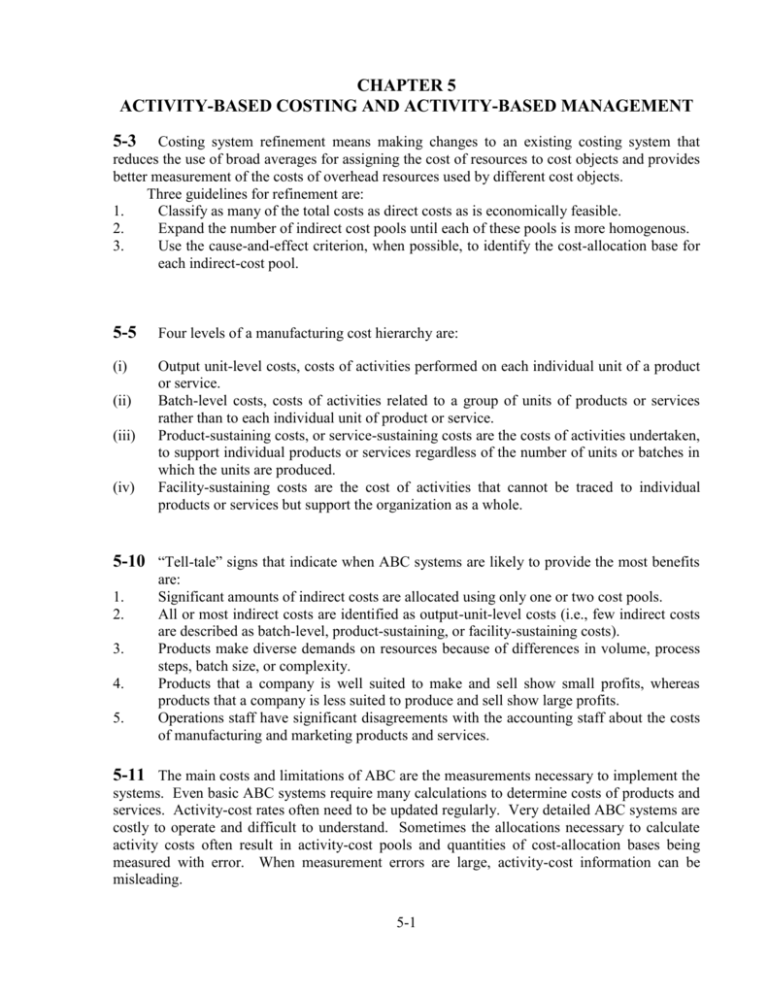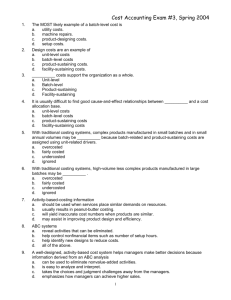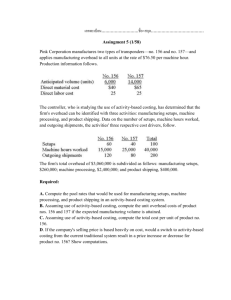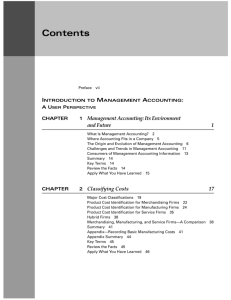here
advertisement

CHAPTER 5 ACTIVITY-BASED COSTING AND ACTIVITY-BASED MANAGEMENT 5-3 Costing system refinement means making changes to an existing costing system that reduces the use of broad averages for assigning the cost of resources to cost objects and provides better measurement of the costs of overhead resources used by different cost objects. Three guidelines for refinement are: 1. Classify as many of the total costs as direct costs as is economically feasible. 2. Expand the number of indirect cost pools until each of these pools is more homogenous. 3. Use the cause-and-effect criterion, when possible, to identify the cost-allocation base for each indirect-cost pool. 5-5 Four levels of a manufacturing cost hierarchy are: (i) Output unit-level costs, costs of activities performed on each individual unit of a product or service. Batch-level costs, costs of activities related to a group of units of products or services rather than to each individual unit of product or service. Product-sustaining costs, or service-sustaining costs are the costs of activities undertaken, to support individual products or services regardless of the number of units or batches in which the units are produced. Facility-sustaining costs are the cost of activities that cannot be traced to individual products or services but support the organization as a whole. (ii) (iii) (iv) 5-10 “Tell-tale” signs that indicate when ABC systems are likely to provide the most benefits 1. 2. 3. 4. 5. are: Significant amounts of indirect costs are allocated using only one or two cost pools. All or most indirect costs are identified as output-unit-level costs (i.e., few indirect costs are described as batch-level, product-sustaining, or facility-sustaining costs). Products make diverse demands on resources because of differences in volume, process steps, batch size, or complexity. Products that a company is well suited to make and sell show small profits, whereas products that a company is less suited to produce and sell show large profits. Operations staff have significant disagreements with the accounting staff about the costs of manufacturing and marketing products and services. 5-11 The main costs and limitations of ABC are the measurements necessary to implement the systems. Even basic ABC systems require many calculations to determine costs of products and services. Activity-cost rates often need to be updated regularly. Very detailed ABC systems are costly to operate and difficult to understand. Sometimes the allocations necessary to calculate activity costs often result in activity-cost pools and quantities of cost-allocation bases being measured with error. When measurement errors are large, activity-cost information can be misleading. 5-1 5-16 (30 min.) Cost smoothing or peanut-butter costing, cross-subsidization. 1. Cost smoothing or peanut-butter costing is a costing approach that uniformly assigns the cost of resources to customers when the individual customers use those resources in a nonuniform way. The reunion dinner averages the costs across all five people. These five people differ sizably in what they consume. 2. Diner Entree Dessert Drinks Armstrong $27 $8 $24 Gonzales 24 3 0 King 21 6 13 Poffo 31 6 12 Young 15 4 6 Average $23.60 $5.40 $11.00 The average-cost pricing will result in each person paying $40. Total $59 27 40 49 25 $40.00 Amount Over- or (Undercosted) Accurately costed person • King, $40 – $40 Undercosted people • Armstrong, $40 – $59 • Poffo, $40 – $49 Overcosted people • Gonzales, $40 – $27 • Young, $40 – $25 $ 0 $(19) $( 9) $ 13 $ 15 Yes, Young's complaint is justified. He is "overcharged" $15. He could point out likely negative behaviors with this approach to costing. These include: a. It can lead some people to order the most expensive items because others will "subsidize" their extravagance. b. It can lead to friction when those who dine economically are forced to subsidize those who dine extravagantly. At the limit, some people may decide not to attend the reunion dinners. a. b. Likely benefits of this approach are: it is simple, and it (purportedly) promotes a group atmosphere at the dinner. 3. Each one of the costs in the data is directly traceable to an individual diner. This makes it straightforward to compute the individual cost per diner. Examples where this is not possible include: • A plate of hors d'oeuvres is shared by two or more diners • A loaf of garlic bread is shared by two or more diners • A bottle of mineral water or wine is shared by two or more diners 5-2 Each of these items cannot be directly traced to only one diner. Some possible behaviors if each person pays for his or her own bill are: a. b. c. Some people may reduce their ordering of more expensive items because they will not be subsidized by other diners. May encourage some potential diners to attend who otherwise would have stayed away. May encourage a person "trying to impress others with his or her success" to order the most expensive items. 5-17 (20 min.) Cost hierarchy. 1. a. Product-sustaining costs are costs of activities undertaken to support individual products regardless of the number of units or batches in which the product is produced. Costs of designing processes, drawing process charts, and making engineering changes for individual products, $800,000, are product-sustaining costs. b. Batch-level costs are costs of activities that are related to a group of units of a product rather than each individual unit of a product. Purchase order-related costs (including costs of receiving materials and paying suppliers) of $500,000 are batch-level costs c. Output unit-level costs are costs of activities performed on each individual unit of a product. Direct materials costs of $6,000,000 are output unit-level costs. d. Setup costs of $600,000 are batch-level costs. e. Direct manufacturing labor costs of $1,000,000 are output unit-level costs. f. Machine-related overhead costs (depreciation and maintenance) of $1,100,000 are output unit-level costs. g. Facility-sustaining costs are costs of activities that cannot be traced to individual products or services but support the organization as a whole. Plant management, plant rent, and insurance costs of $900,000 are facility-sustaining costs. 2. The complex boom box made in many batches will use significantly more batch-level overhead resources compared to the simple boom box that is made in a few batches. In addition, the complex boom box will use more product-sustaining overhead resources because it is complex. Because each boom box requires the same amount of machine-hours, both the simple and the complex boom box will be allocated the same amount of overhead costs per boom box if Telecom uses only machine-hours to allocate overhead costs to boom boxes. As a result, the complex boom box will be undercosted (it consumes a relatively high level of resources but is reported to have a relatively low cost) and the simple boom box will be overcosted (it consumes a relatively low level of resources but is reported to have a relatively high cost). 3. Using the cost hierarchy to calculate activity-based costs can help Telecom to identify both the costs of individual activities and the cost of activities demanded by individual products. Telecom can use this information to manage its business in several ways. (1) Pricing and product mix decisions. Knowing the resources needed to manufacture and sell different types of boom boxes can help Telecom to price the different boom boxes and also identify which boom boxes are more profitable. It can then emphasize its more profitable products. 5-3 (2) Telecom can use information about the costs of different activities to improve processes and reduce costs of the different activities. Telecom could have a target of reducing costs of activities (setups, order processing, etc.) by, say, 3% and constantly seek to eliminate activities and costs (such as engineering changes) that its customers perceive as not adding value. (3) Telecom management can identify and evaluate new designs to improve performance by analyzing how product and process designs affect activities and costs. (4) Telecom can use its ABC systems and cost hierarchy information to plan and manage activities. What activities should be performed in the period and at what cost? 5-4 5-27 (2025 min.) Activity-based costing, job-costing system. 1. An overview of the activity-based job-costing system is: INDIRECT COST POOL COST ALLOCATION BASE COST OBJECT: PC BOARD Axial Insertion Dip Insertion Manual Insertion Wave Solder Backload Test Defect Analysis Number of Axial Insertions Number of Dip Insertions Number of Manual Insertions Number of Boards Soldered Number of Backload Insertions Budgeted Time in Test Budgeted Time in Analysis DIRECT COST Indirect Costs Direct Costs Direct Manufacturing Direct Materials Labor 2. Activity Area Indirect Manufacturing Costs Allocated $ 0.08 45 = $ 3.60 0.25 24 = 6.00 0.50 11 = 5.50 3.50 1 = 3.50 0.70 6 = 4.20 90.00 .25 = 22.50 80.00 .10 = 8.00 $53.30 1. Axial insertion 2. Dip insertion 3. Manual insertion 4. Wave solder 5. Backload 6. Test 7. Defect analysis Total Direct manufacturing costs: Direct materials Direct manufacturing labor Indirect manufacturing costs: Manufacturing overhead (see above) Total manufacturing costs $75.00 15.00 $ 90.00 53.30 $143.30 3. The manufacturing manager likely would find the ABC job-costing system useful in cost management. Unlike direct manufacturing labor costs, the seven indirect cost pools are systematically linked to the activity areas at the plant. The result is more accurate product costing. Productivity measures can be developed that directly link to the management accounting system. Marketing managers can use ABC information to price jobs as well as to advise customers about how selecting different product features will affect price. 5-5 5-33 (30 min.) Plantwide versus department overhead cost rates. 1. Molding Manufacturing department overhead Service departments: Power Maintenance Total budgeted plantwide overhead Amounts (in thousands) Component Assembly $21,000 $16,200 $22,600 = $59,800 18,400 4,000 $82,200 Budgeted direct manufacturing labor-hours (DMLH): Molding Component Assembly Total budgeted DMLH Plantwide overhead rate = Total 500 2,000 1,500 4,000 Budgeted plantwide overheard Budgeted DMLH $82,200 = $20.55 per DMLH 4,000 2. The department overhead cost rates are shown in Solution Exhibit 5-33 3. MumsDay Corporation should use department rates to allocate plant overhead because: (1) the cost drivers of resources used in each department differ and (2) the departments do not use resources from the support departments in the same proportion. Hence, department rates better capture cause-and-effect relationships at MumsDay than does a plantwide rate. 4. MumsDay should further subdivide the department cost pools into activity-cost pools if (a) significant costs are incurred on different activities within the department, (b) the different activities have different cost drivers, and (c) different products use different activities in different proportions. 5-6 5-33 (Cont’d) SOLUTION EXHIBIT 5-33 Departments (in thousands) Service Manufacturing Power Maintenance Molding Component 2 (a) Departmental overhead costs Allocation of maintenance costs (direct method) $4,000 × 90/125, 25/125, 10/125 Allocation of power costs $18,400 × 360/800, 320/800, 120/800 Total budgeted overhead of manufacturing departments $18,400 $4,000 $21,000 $16,200 $22,600 (4,000) 2,880 800 320 8,280 7,360 2,760 $32,160 $24,360 $25,680 (18,400) $ 0 $ 2 (b) Allocation Base Budgeted Rate (Budgeted overhead ÷ Alloc. Base) 5-7 Assembly 0 875 MH 2,000 DMLH 1,500 DMLH $36.75/MH $12.18/DMLH $17.12/DMLH 5-34 (30-40 min.) Activity-based costing, merchandising. 1. Revenuesa Cost of goods soldb Gross margin Other operating costs Operating income Gross margin % General Supermarket Chains $3,708,000 3,600,000 $ 108,000 Drugstore Chains $3,150,000 3,000,000 $ 150,000 2.91% 4.76% Ma and Pa Single Stores $1,980,000 1,800,000 $ 180,000 Total $8,838,000 8,400,000 438,000 301,080 $ 136,920 9.09% a($30,900 120); ($10,500 300); ($1,980 1,000) b($30,000 120); ($10,000 300); ($1,800 1,000) The gross margin of Figure Four Inc. was 4.96% ($438,000 ÷ $8,838,000). The operating income margin of Figure Four Inc. was 1.55% ($136,920 ÷ $8,838,000). 2. 1. 2. 3. 4. 5. 3. The per-unit cost driver rates are: Customer purchase order processing, $80,000 ÷ 2,000 orders Line item ordering, $63,840 ÷ 21,280 line items Store delivery, $71,000 ÷ 1,420 deliveries Cartons shipped, $76,000 ÷ 76,000 cartons Shelf-stocking, $10,240 ÷ 640 hours The activity-based costing of each distribution market for August 2002 is: General Supermarket Chains 1. 2. 3. 4. 5. = $40 per order = $ 3 per line item = $50 per delivery = $ 1 per carton = $16 per hour Customer purchase order processing, ($40 140; 360; 1,500) Line item ordering, ($3 (140 14; 360 12; 1,500 10)) Store delivery, ($50 120, 300, 1,000) Cartons shipped, ($1 (120 300; 300 80; 1,000 16)) Shelf-stocking, ($16 (120 3; 300 0.6; 1,000 0.1)) 5-8 Drugstore Chains Ma and Pa Single Stores $ 5,600 $14,400 $ 60,000 5,880 12,960 45,000 6,000 15,000 50,000 36,000 24,000 16,000 5,760 $59,240 2,880 $69,240 1,600 $172,600 5-34 (Cont’d.) The revised operating income statement is: General Supermarket Chains Revenues $3,708,000 Cost of goods sold 3,600,000 Gross margin 108,000 Operating costs 59,240 Operating income $ 48,760 Operating income margin 1.31% Drugstore Chains $3,150,000 3,000,000 150,000 69,240 $ 80,760 Ma and Pa Single Stores $1,980,000 1,800,000 180,000 172,600 $ 7,400 Total $8,838,000 8,400,000 438,000 301,080 $ 136,920 2.56% 0.37% 1.55% The ranking of the three markets are: Using Gross Margin 1. 2. 3. Ma and Pa Single Stores Drugstore Chains General Supermarket Chains Using Operating Income 9.09% 4.76% 2.91% 1. Drugstore Chains 2. General Supermarket Chains 3. Ma and Pa Single Stores 2.56% 1.31% 0.37% The activity-based analysis of costs highlights how the Ma and Pa Single Stores use a larger amount of Figure Four resources per revenue dollar than do the other two markets. The ratio of the operating costs to revenues across the three markets is: General Supermarket Chains Drugstore Chains Ma and Pa Single Stores 1.60% 2.20% 8.72% ($59,240 ÷ $3,708,000) ($69,240 ÷ $3,150,000) ($172,600 ÷ $1,980,000) This is a classic illustration of the maxim that "all revenue dollars are not created equal." The analysis indicates that the Ma and Pa Single Stores are the least profitable market. Figure Four should work to increase profits in this market through: (1) a possible surcharge, (2) decreasing the number of orders, (3) offering discounts for quantity purchases etc. 4. a. Choosing the appropriate cost drivers for each area. The problem gives a cost driver for each chosen activity area. However, it is likely that over time further refinements in cost drivers would occur. For example, not all store deliveries are equally easy to make, depending on parking availability, accessibility of the storage/shelf space to the delivery point, etc. Similarly, not all cartons are equally easy to deliver––their weight, size, or likely breakage component are factors that can vary across carton types. b. Developing a reliable data base on the chosen cost drivers. For some items, such as the number of orders and the number of line items, this information likely would be available in machine readable form at a high level of accuracy. Unless the delivery personnel have hand-held computers that they use in a systematic way, estimates of shelf-stocking time are likely to be unreliable. Advances in information technology likely will reduce problems in this area over time. c. Deciding how to handle costs that may be common across several activities. For example, (3) store delivery and (4) cartons shipped to stores have the common cost of the same trip. Some organizations may treat (3) as the primary activity and attribute only incremental costs to (4). Similarly, (1) order processing and (2) line item ordering may have common costs. 5-9 5-34 (Cont’d.) d. Choice of the time period to compute cost rates per cost driver. Flair calculates driver rates on a monthly basis (August 2002). He may want to consider using longer time periods that may be less affected by seasonal or random variations in demand. e. Behavioral factors are likely to be a challenge to Flair. He must now tell those salespeople who specialize in Ma and Pa accounts that they have been less profitable than previously thought. See Excel file for Spreadsheet version 5-10








